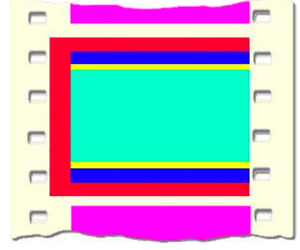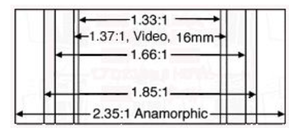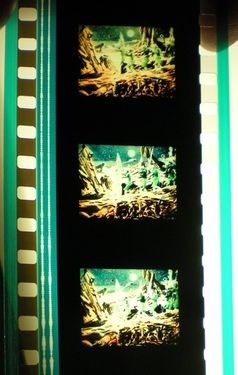| Welcome to Sprocket School! This project is maintained by volunteer editors. Learn more about how this works. |
Aspect ratios: Difference between revisions
Jump to navigation
Jump to search
| Line 43: | Line 43: | ||
===Determining 35mm aspect ratios for projection=== | ===Determining 35mm aspect ratios for projection=== | ||
For some [[film gauges]], the aspect ratio will be obvious. 16mm is rarely anything but full frame (though there are variations - see | For some [[film gauges]], the aspect ratio will be obvious. 16mm is rarely anything but full frame (though there are variations - see [[16mm]] page). Other small gauges are rarely anything but their native aspect ratios. [[35mm]], however, can be complicated. | ||
* The first way to determine the aspect ratio is to find out when the film was made and using your knowledge of film history, assign its aspect ratio. | * The first way to determine the aspect ratio is to find out when the film was made and using your knowledge of film history, assign its aspect ratio. | ||
| Line 59: | Line 59: | ||
* [[List of 35mm features released in 1.37 after 1953]] | * [[List of 35mm features released in 1.37 after 1953]] | ||
==Small Gauges: 8mm, Super 8, etc.== | ==Small Gauges: 8mm, Super 8, etc.== | ||
Revision as of 17:23, 19 September 2016

The aspect ratio is the ratio of the projected image's width:height when projected on the screen or printed on the film.
- define soft + hard matting, "native" aspect ratio, etc.
35mm
-
Aspect ratios as they appear in the film frame.
Red 1.33, Blue 1.37, Yellow 1.66, 'Green 1.85 -
Aspect ratios as they appear on a full-width screen.
| Aspect Ratio | Other names | Year of Introduction | Image | Notes |
|---|---|---|---|---|
| 1.33:1 | Silent / Full Frame | 1907 | ||
| 1.19:1 | Movietone | 1926 | Often projected with 1.37 lenses in theaters without specialized 1.19 lenses; however, doing this will chop off a substantial portion of the image. | |
| 1.37:1 | Academy ratio | 1932 | Sometimes incorrectly called 1.33. Was used well past 1953 in some countries outside of the US. See also: List of 35mm features released in 1.37 after 1953. | |
| Windowboxed 1.37:1 | ? | Projected with a 1.85 lens and aperture plate, these prints are often rereleases of films made in traditional 1.37 that will be shown in wide release at theaters not outfitted with 1.37 lenses. | ||
| 1.66:1 | 1953 | Warning: widescreen formats may be soft-matted | ||
| 1.78:1 | Used for films that originated on video. | |||
| 1.85:1 | Flat | 1953 | Warning: widescreen formats may be soft-matted | |
| 2.39:1 | CinemaScope / Anamorphic | 1953 | Historically, CinemaScope aspect ratios have varied. Today's lenses are mostly calibrated for 2.39:1. |
35mm aspect ratio gallery
-
1.33 Full Frame silent print of Joan of Arc
-
Hard-matted 1.85:1
-
Windowboxed 1.37:1
Determining 35mm aspect ratios for projection
For some film gauges, the aspect ratio will be obvious. 16mm is rarely anything but full frame (though there are variations - see 16mm page). Other small gauges are rarely anything but their native aspect ratios. 35mm, however, can be complicated.
- The first way to determine the aspect ratio is to find out when the film was made and using your knowledge of film history, assign its aspect ratio.
- The second and complementary way is to look at a frame of the print and using the different aperture plates, try to eyeball which looks best.
Be aware that there are always exceptions to any these rules. And: don't just trust IMDb!
- Determining correct aspect ratios for widescreen, etc.
- Do not always trust what's written on the can or on the print! If you receive a print that is incorrectly labeled (and you are certain of it) make sure to correct it.
- Eyeballing and measuring
- Educated guesses based on year, studio, country, etc
- Caveat: there is no "correct," historically - so contentious!
- For films that have been released on DVD or Blu-Ray there is often a lot of information online about the "original" aspect ratio of the film. Sites like IMDB and TCM can be helpful, but always use this information along with one of the above techniques as they are not always correct!
Small Gauges: 8mm, Super 8, etc.
- Super 8 - 1.36:1
- 9.5mm - 1.31:1
- 28mm - 1.36:1
Related Pages
- 16mm See: 16mm aspect ratios
- 70mm See: 70mm aspect ratios
- Aperture plate
- Lens
- Masking
External Links
- Essay: Invasion of the Aspect Ratios
- Advice from Jean-Pierre Léaud: YouTube




